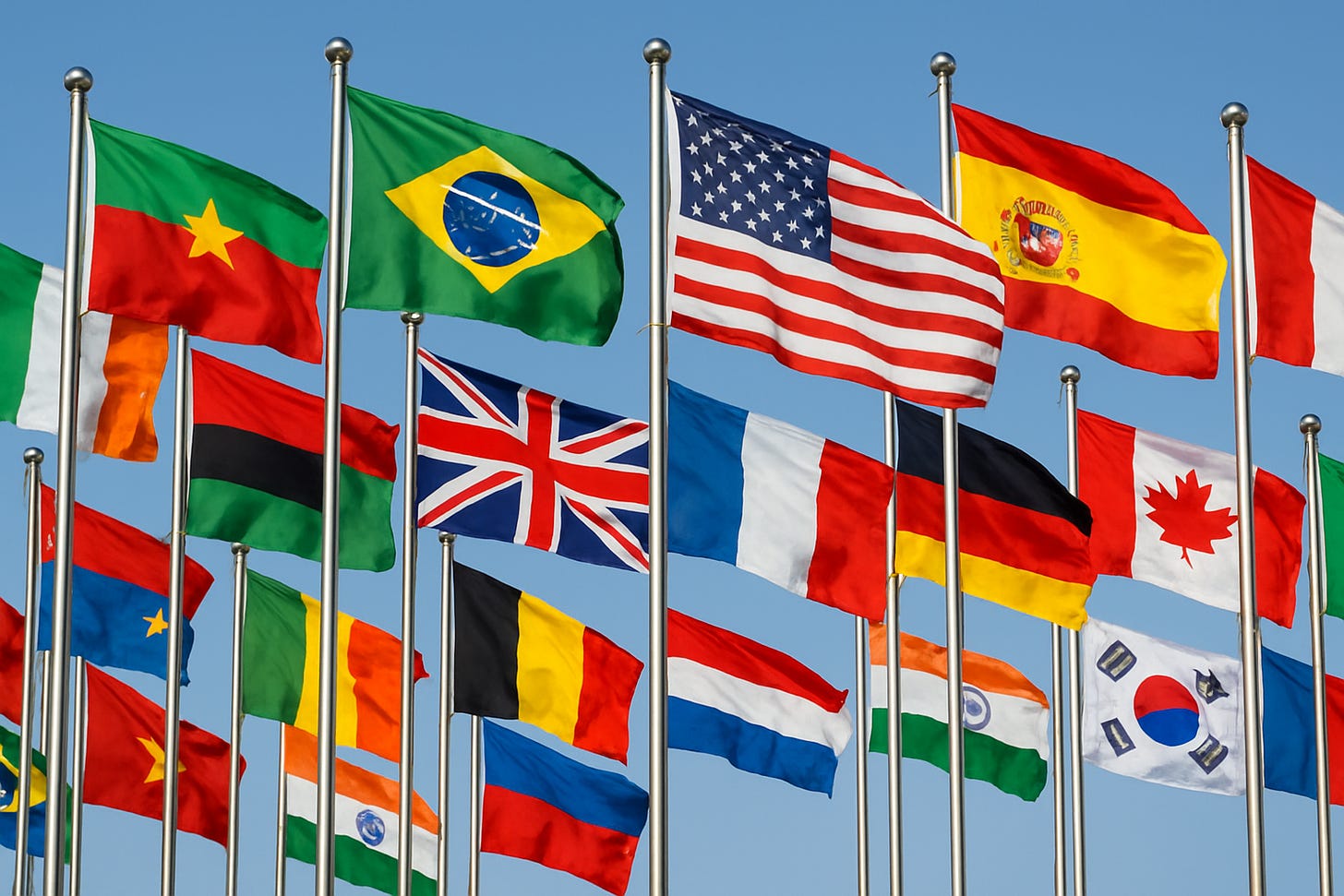Attack the Week (ATW)
Flags, Tariffs and Macro Forces
Sunday Thoughts
We were invited to a friend’s dinner this weekend. It is a usual quarterly get-together, although this time around the hosts asked us to come dressed in the colours of a national flag. I didn’t spend much time thinking and reverse-engineered my usual white sneakers, black jeans and blue shirt look, which handily resembles the colours of Estonia. My wife and another friend both turned up in Argentinian colours. Easy wins. A joyous evening then turned into marvelling at all the different flags of the world, while exploring fun facts late into the night.
Most national flags share common colours, but the meanings behind them can differ widely. Red, for example, often stands for the blood of patriots or revolution (as in Kenya or Vietnam), but in China it symbolises the Communist Revolution and prosperity. Blue may represent freedom and justice, as it does in the U.S. and France, but in Somalia, it stands for the United Nations' role in the country's early independence. Green is frequently linked to Islam, particularly in Middle Eastern nations, but it also symbolises agriculture or hope in many African flags.
Despite their common shapes and colours, flags hold surprising secrets. For instance, Nepal’s flag is the only national flag that isn’t rectangular — it’s made of two stacked triangles, symbolising the Himalayas and the two major religions, Hinduism and Buddhism. Switzerland and the Vatican City also defy flag norms with their square shapes. Another little-known fact: the flag of Mozambique features an AK-47, making it the only national flag to depict a modern weapon.
Colours can shift with context. The black in the German flag, for instance, once symbolised a dark past of tyranny and war, but was reclaimed after World War II to represent determination and the overcoming of adversity. The Jamaican flag uniquely features no colours from a colonial past (like red, white, or blue); its black, green, and gold represent the resilience of its people, lush land, and natural wealth, respectively—a pointed declaration of post-colonial pride.
Flags also reflect economic aspirations. Consider the stars on the European Union flag, which represent unity and harmony among peoples of Europe, or the South Korean flag, which incorporates yin-yang and trigrams to symbolise balance, growth, and universal harmony—ideals foundational to economic and societal order. For investors and economists, flags offer more than colour; they signal a nation’s worldview, priorities, and historical baggage. In a world driven by trade and geopolitics, learning to "read" a flag can sometimes tell you more than a spreadsheet ever will.
In theory, the post-World War II era sought to replace flag-waving nationalism with cooperation, most visibly through institutions like the United Nations, the World Trade Organisation, and the European Union. Yet today, despite those globalist dreams, flags are reasserting themselves not as signs of unity, but as markers of division. The rise of tariffs, trade wars, and economic nationalism suggests that the era of harmonised global commerce is fraying at the edges.
This return to economic self-determination is evident in the recent wave of tariff escalations and now a growing chorus of protectionist policies across the Global South. Countries are not simply reacting to economic pressures; they are reclaiming agency. The flags at global summits now represent diverging interests rather than a shared playbook. This shift signals not just a cooling of global integration, but a recalibration of priorities —national resilience, industrial self-sufficiency, and strategic autonomy are the new watchwords.
For us as investors and market observers, this is both a warning and a signal. A fragmented world means less predictability, more regionalisation, and increasingly complex supply chains. But it also means opportunity. The macro landscape is widening: countries once overlooked are emerging as critical players in commodity cycles, defence manufacturing, and clean energy transitions. Portfolio strategies must now consider geopolitical risk not as a tail event, but as a baseline factor — shaping currencies, valuations, and cross-border capital flows.
In this polarised world, the meanings behind flags matter more than ever. They are not merely symbols — they are strategic statements. As nations prioritise economic identity over integration, we enter a macro world where conviction must be balanced with caution. The flags are speaking, and the message is clear: the next chapter in global markets won’t be written in unison — it will be a negotiation of visions.
Much of the market’s focus is on linear concepts and cyclical patterns, forgetting that the true forces are still very much in their early stages. We assume that tariffs are going to be non-events, forgetting that self-interest by itself would make retaliation and non-cooperation the more likely outcomes. I see patterns and large macro forces unfolding way beneath the visible spectre of charts and valuations. Financial repression will be one of many future words and strategies, trying to support countries’ domestic bond markets, closing free capital flows in order to channel domestic savings towards investment places of national interest. Inflation/Disinflation might be a secondary concern in such a macro setting. The future is bright. I am running towards it with full excitement.
Let’s now read some additional thoughts from Macro D on the current state of markets and Japan’s fate and the Yen, before we scan the weekly macro calendar, check a few interesting chart setups and update the weekly asset allocation model for its latest change and performance.
Have a successful week ahead




